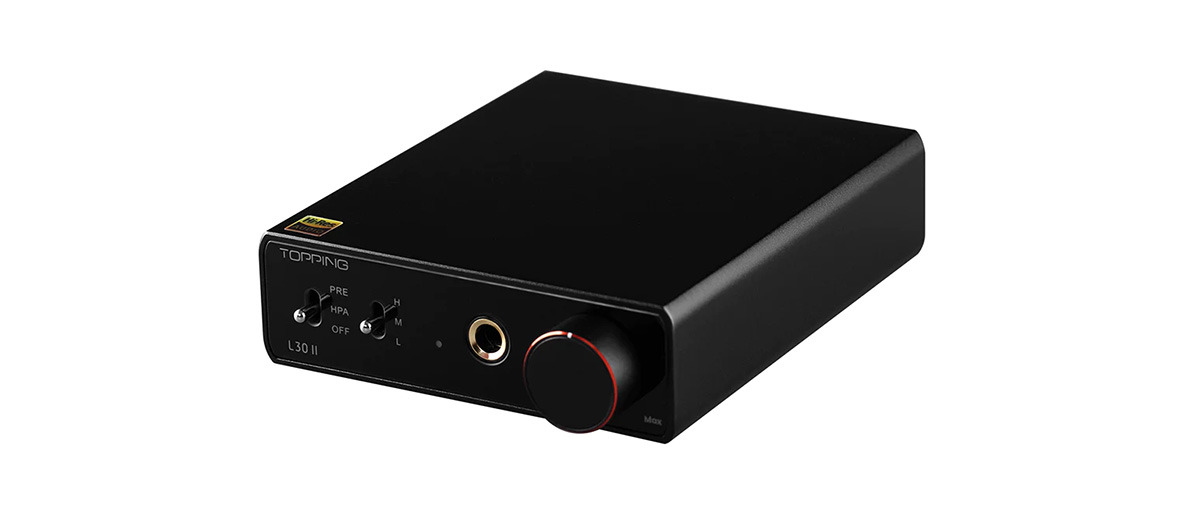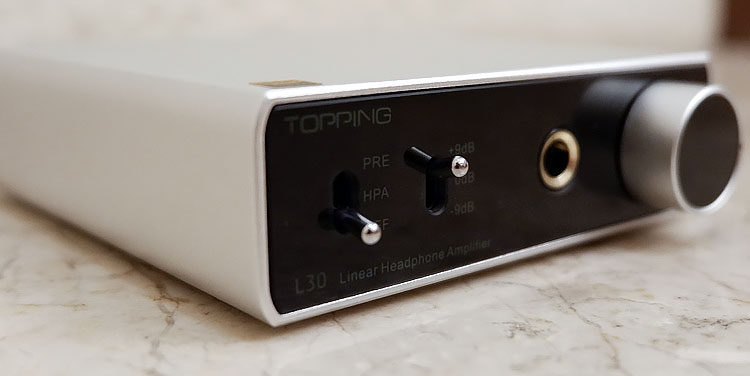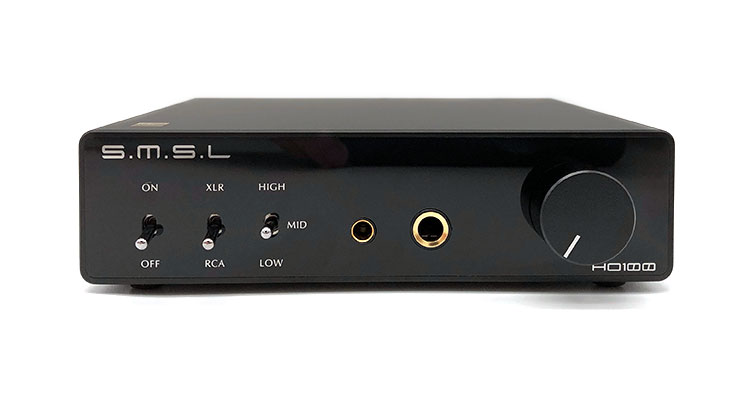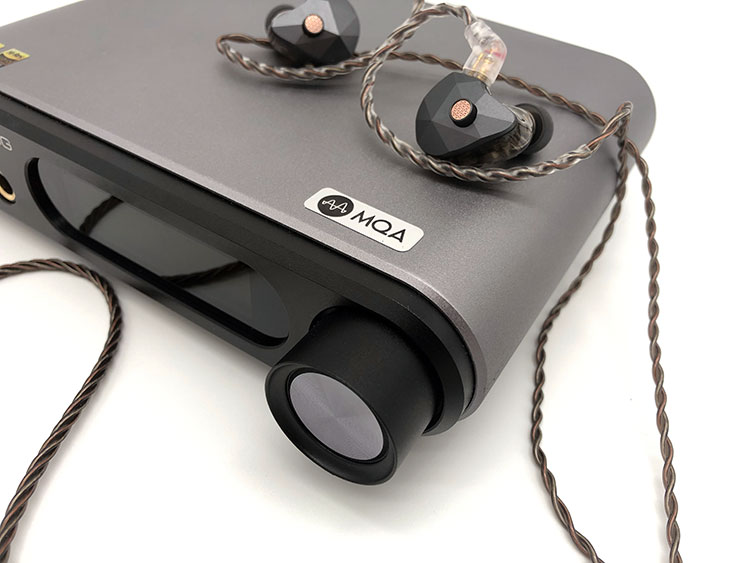Select Comparisons
Topping L30
$149.99
Technical
Just like the E30 II, finding the updates on the L30 II will quickly turn into a game of spotting the difference. Feature-wise it is still the same amplifier as the L30 but now with a spec bump in terms of numbers spread across the board.
Quite not definite on what has changed with the NFCA module, we just have to take Topping’s word that the circuit has been better optimized on the L30 II. Supporting this is the higher dynamic range and lower THD+N coming from the newer amplifier.
What stayed though is already beefy for its class 3.5W of power for 16Ω loads and the friendly <0.1Ω output impedance. Hiding a trick up its sleeve, read through the capabilities of the L30 II and you’ll see the higher 560W it can give to 300Ω cans.
As if to say the old design needs to be improved in every way, Topping also touched the gain setting to now be wider than before. What used to be set to -9.9dB for low gain now goes down to -14dB while the 9dB high gain is changed to 16.5 dB.
Design
Having the same chassis, the L30 II won’t be new to owners of the previous design. While the internal upgrades let Topping get away with reusing an old design, it would have been nice if something is exciting to separate it from the L30.
Looking into the little details, I still found differences and don’t know how useful or important these will be to the end user. Aside from the rebadge to the L30 II model name, the newer version also uses a bigger white power indicator.
Performance
I was initially prepared to have a hard time comparing the L30 and the L30 II since I was expecting a minimal difference separating the two. Boy was I wrong. The L30 is what I would associate to be the Topping sound, while the L30 II is a more casual but still honest amplifier.
With its lighter sub-bass, subtler details are easier to get lost in the L30. The surer bite and added room information of the L30 II is an obvious upgrade that I could tell a lot is missing with the older device.
The L30 keeps a thinner timbre for guitars and vocals and so I noticed that Topping changed the L30 II to have a girthier lower midrange adding fullness to the sound. Also, the L30 is a lot shoutier and is easily the more fatiguing amp for long listening.
It continues to the treble region with the L30 II being more even and pleasing. The violin even with its more forward presence on the L30 is not as inviting and is less sweet.
The L30 II makes it easier to separate two overlapping objects as it also sounds a few paces farther in width. But compared to what I was saying earlier with the L30 II, the placement of objects on the L30 is less rigid.
SMSL HO100
$149
Technical
Using an ultra-low distortion precision feedback circuit and an ultra-low noise power supply, the THD+N of the HO100 matches that of the L30 II. Topping gets a slight upper hand due to the half-watt boost it has in the power department.
For IEM users, the L30 II has your back with its lower -14dB low gain setting. SMSL went close but still fell short in the greater high-gain freedom the L30 II provides.
Where the two splits in SMSL’s favor are in inputs. While it lacks a preamp mode, as the bigger device, it fits comfortably in its rear a pair of full-size XLR sockets for balanced listening requirements.
Design
Without some previous knowledge, I probably wouldn’t be able to tell from the outside that the two amps are priced the same. With a bigger case and a higher number of toggle switches and IO including a 4.4mm headphone jack, the HO100 seems to be more substantial.
I will however rehash my previous praise of the volume wheel used by Topping. As the smaller of the two, the L30 II had the chance to maximize on materials used since I am simply not too fond of the rubbery and cheap-feeling knob on the HO100.
Another thing I noticed while using both amps is the snappy 6.35mm socket Topping used for the L30 II. Plugging and unplugging headphones on the HO100 is slower as it grabs the jack harder before clicking into place.
Performance
With a slightly deeper rumble than the L30 II, the HO100 has a thing or two to say in terms of bass presentation. Drums are faster and punchier, and at the same time also provide some added scale to thumps.
I’m getting pretty close detail retrieval between the two but the HO100 does have some occasional moments where it shows a bit more finesse than the L30 II. This is especially the case with brighter singers where the HO100 returns more openness and air.
With the lighter timbre on the HO100 in contrast to the way the L30 II puts more body to guitars, the delivery of plucks on Topping is smoother.
On the other hand, expect a more energetic violin performance over at the SMSL side with its shinier and bigger profile.
Topping DX5
$449
Technical
Ending the comparison section with a DAC/Amp from the same company, the price difference can be attached to the digital horsepower Topping installed to the DX5.
With two ES9068AS DAC chips, Bluetooth, and full MQA decoding, the DX5 is a full-blown converter with balanced XLR rear outputs if needed.
As a headphone amplifier, the DX5 also has an NFCA module inside that mirrors the signal to both the 6.35mm and four-pin XLR in front.
Against the power aptitude of the L30 II to match the 32W load spec of the DX5, the DX5 is lower by a bit as it remains at 1.8W per channel whereas the L30 II can go up to 2.7W.
Design
Fresher and more inspired, there’s no denying that the DX5 is the more eye-catching device. With more visual cues to catch the onlooker, it explains why it has two design awards and the L30 II doesn’t.
Against the stealthy L30 II, the DX5 is given more contrast by having a two-tone design. And since it has a digital controller, Topping was able to squeeze all functional settings of the DX5 into a single knob without the need for old-school switches.
The DX5 is a lot heavier as it sits at 735g. The bigger case though doesn’t look too bulky as the edges have been curved to wrap around the volume wheel and the XLR output in front for a tighter look.
Performance
Closer to what I expected from Topping, the DX5 returned a more mature-sounding bass that has more control and tightness over the L30 II. Even without the girth and lift of the L30 II, the DX5 is revealing enough to show the subtler parts of a song though at a less amount.
For treble heads, the DX5 has a livelier upper midrange making it steelier and not as soft as the L30 II. Being thinner in tonality though could affect listening session duration but still, I can’t stress enough the merit of the DX5 in isolation and placement.
I like the L30 II in how it makes a relaxing and fuller violin performance. But asking back for attention, the DX5 shows skill in return in dynamics as it doesn’t compress live and dynamic scenes as much.
The DX5 in dissecting a busy round of applause showed its height, resolution, and depth advantage.
Staging-wise, the L30 II becomes limited when placed side by side with the DX5. With less separation and more emphasized images, the holographic quality of the L30 II seems more walled in.
Our Verdict
As a successor to the L30, the changes to the new Topping L30 II aren’t limited to just numbers on paper. It translates well to real-world results with improved detail and tuning over the original. The biggest accomplishment though is to keep the original asking price while upgrading all the technical specs.
However, since it is sharing the same face as the original, it is unashamedly asking to be associated. I think the new version is different enough sonically that Topping could have made the update more obvious.
When it comes to technicalities, it is still not perfect though. And once you factor in close competitors, we can see how neck and neck companies are in developing the next best amplifier in this budget segment.
Topping L30 II Technical Specifications
Headphone amplifier specs
- THD+N @1kHz (A-wt): <0.00006% @500mW (32Ω), <0.00005% @80mW (300Ω)
- THD @ 20-20kHz 90kBW: <0.00008% @500mW (32Ω), <0.00007% @80mW (300Ω)
- SNR @MAX OUT 1kHz (A-wt): 144dB
- Dynamic range @1kHz (A-wt): 144dB
- Frequency response: 20Hz – 40kHz (±0.05dB)
- Gain: Low gain -14dB, Medium gain 0dB, High gain 16.5dB
- Output impedance: <0.1Ω
- Output power: 3500mW x2 @16Ω THD+N <0.1%
Pre-amplifier specs
- THD+N @1kHz (A-wt): <0.00006%
- THD @20-20kHz 90kBW: <0.00007%
- SNR @MAX OUT 1kHz (A-wt): 144dB
- Dynamic range @1kHz (A-wt): 144dB
- Frequency response: 20Hz – 40kHz (±0.05dB)
- Gain: Low gain -14dB, Medium gain 0dB, High gain 16.5dB
- Output impedance: 20Ω






